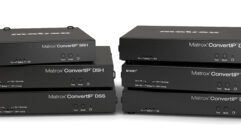
School District Adds Streaming Video System
The Metropolitan School District of Warren Township integrates a cost-effective video capture and distribution system on its fiber optic infrastructure.
The network operations center (NOC) in the Metropolitan School District (MSD) in Warren Township, Ind., houses Cisco 6500 core routers, which distribute voice, data, and video communication to all 19 buildings in the district. It also includes 65 computer servers for management, an IBM NAS/SAN solution with approximately 5 Terabytes of storage, and a Nortel Succession 1000 VoIP phone switch that provides inbound and outbound calls to each building.Signal distribution
CHALLENGE: Transition from a coax network onto fiber, and add streaming live video broadcasts and video- on-demand capabilities.
SOLUTION: Install an Ethernet-based system that can work with the school’s Active Directory to distribute and capture video signals on the existing fiber infrastructure.
WHILE MANY K-12 school districts are just now getting up to speed with their AV technology infrastructures, districts like the Metropolitan School District (MSD) of Warren Township, IN, located east of Indianapolis, have set an example. With a history of strong IT leadership and technology adoption, the township’s 12,550 K-12 students have access to AV technology and IT networks that rival corporate facilities.
Eight years ago, the school district installed its coax network using community resources. The MSD held an event called “Net Days,” which encouraged the 90,000 citizens in the township to help wire the schools — literally. “Most of the labor was provided by parents and people in the community,” says Brian Woods, director of network operations for MSD, whose responsibilities include keeping the network operational as well as the VoIP phone system in all 19 MSD buildings.
Three years later, the school district began its “Vision 2005” fundraising effort, which was designed to provide improvements and technology upgrades to several buildings. The effort was so successful that MSD partnered with Indiana Fiber Works to run fiber optic cable to all 19 buildings, and set up the main administrative building as the network operating center (NOC) for the district (see sidebar on page 22).
“The fiber infrastructure now carries all phone, video, and data signals,” Woods says. “We were previously on a fractional T1, but MSD Warren Township worked out a deal with Indiana Fiber Works for a ‘dark’ fiber install. Dark fiber meant there was no service, so we could provide the 1 Gigabit Ethernet service to each building ourselves.”
The new fiber network also signaled the birth of the school district’s video distribution system between its 11 elementary schools, three middle schools, and one high school.
Previously, schools only had AV carts. Vision 2005 financed the purchase of one Zenith 32-inch H32F46DT SVGA-resolution TV monitor for each classroom, which were networked to the head end via fiber.
Separately, MSD allocated portions of a $6 million grant from the Eli Lilly Endowment to provide TV studios in each school building, which are used for daily morning announcements and for students to develop their own movies. The movies are used to show parents and administrators the day-to-day activities of the student body.
With the fiber optic network in place, the school district wanted to find a way to distribute its library of approximately 2,000 video titles and eliminate the need to manually deliver DVDs and VHS tapes from school to school.
School District Adds Streaming Video System
The Metropolitan School District of Warren Township integrates a cost-effective video capture and distribution system on its fiber optic infrastructure.
Active directory
To address the problem, Woods and Jack Polson, network manager for the MSD, worked with Noblesville, IN-based systems integrator IDSolutions to install VBrick’s EtherneTV solution.
“The school district had a basic design in mind, and the 1 Gigabit Ethernet network meant there was plenty of bandwidth to stream video over the network,” says Zac Cook, regional sales director for the Midwest region at IDSolutions. “The goal for the first application was the ability to distribute video signals through the network and capture the content on a video-on-demand (VOD) server.”
The install includes 19 VBrick Model 4200 MPEG-4 encoders and 19 VBrick EtherneTV-STB set-top boxes, each placed at the head end of the media center inside each of the 19 buildings. One VBrick Model 4300 dual encoder, which provides MPEG-4 and MPEG-2 compression, was also installed at the high school head end.
“The actual install was done over the late spring,” Cook says. “It didn’t take long since the system runs over the existing IP network. We just needed power and input jacks.”
Now, with EtherneTV up and running, MSD’s teachers and students can log into the IP network and view live video or content streamed from the server. Video signals are decoded from the head end and are distributed throughout the building via the existing, coax closed-circuit TV network to the TVs in each classroom. To make the transition from coax to fiber, the school used the VBrick system, Cisco routers, and HP ProCurve switches. Each Zenith TV includes a built-in scan converter that receives a signal from a teacher’s computer via a VGA cable. To see the current broadcast, users can tune to a modulated channel on the cable network or watch the live broadcast from any computer in each of the school district’s classrooms.
As a feature of the EtherneTV system, live video can also be saved for later viewing on a VBrick EtherneTV-NXG VOD video server located in the central distribution center in the MSD’s NOC. A VBrick EtherneTV Media Control Server was also installed to manage the EtherneTV system, including the interface that allows users to access the video-on-demand library.
One of the biggest technical challenges occurred when the team integrated EtherneTV with Microsoft Active Directory, a system used district-wide for network user login.
“We have an extensive Active Directory system,” says Polson, who also oversees MSD’s VBrick gear. “From day one, every student gets a username and password, as well as server space for document storage,”
The school district wanted to use the authentication and rights of Active Directory to grant access to content and features on the EtherneTV system. IDSolutions worked closely with Woods and Polson to identify the necessary programming and integrate the setup of Active Directory and EtherneTV. Technical support personnel from VBrick headquarters got involved to help establish a connection to Warren’s Active Directory users and groups, which allowed students and staff to log into the VBrick system with their current usernames and passwords.
The install team also needed to modify the EtherneTV software to enable the district’s media specialists (who oversee the licensing, content updates, and other media requirements for several schools) to provide access and control for the video files they produce. Because the high school’s media specialists needed the ability to create and modify videos before publishing them to the VOD server, VBrick worked with the install team to develop special software that allows authorized media specialists to rename video files after uploading them to the network.
School District Adds Streaming Video System
The Metropolitan School District of Warren Township integrates a cost-effective video capture and distribution system on its fiber optic infrastructure.
For example, district media specialists can now add keyword search information and security settings, so only authorized teachers and students have access to specific video files. This feature provides the district with enhanced content and access control, and enables end-users to save files in multiple locations, such as specific class or project folders. The resulting software update has been so successful that it’s now a standard EtherneTV feature.
As part of the rollout, Woods and Polson also held training sessions for MSD media specialists and teachers. In addition, IDSolutions created a companion operating manual that each school could copy and use.
“The school district had a realistic schedule of testing the system over a full semester to work out any hiccups on the network, establish policy and procedures, and digitize the appropriate content,” Cook says. “So to most of the teachers and students, the rollout seemed smooth.”
Woods says that use of the EtherneTV system has already taken off with the teaching staff. He now sees video clips and original presentations on a regular basis.
“I can see use of the system growing to include more use of video content in class,” Polson adds. With 2.44 Terabytes of storage capability in the server, the school district certainly has room to grow. Currently, only 15 to 20 percent of it is being used due to advanced data compression.
Moving forward, Woods says that MSD continually purchases TVs as new rooms are added. The school district also plans to use the EtherneTV system as a professional development tool. By broadcasting new teacher training and professional development training classes, the district will be able to save on travel expenses. The classes can be made available on an on-demand basis, making it easier for teachers to review training material or catch up on any missed training classes.
The high school also recently extended its digital footprint to an outlying building used for the building trade classes. But because the building doesn’t have fiber running to it, students were missing the video announcements.
To solve the problem, Woods and Polson set up a Cisco wireless connection and a VBrick set-top box. Now, although students are an eighth of a mile away, they can get these announcements. “This is invaluable in case of an emergency,” Woods says.
Over the long term, the MSD of Warren Township will be able to add decoders onto the fiber network as traffic on the coax network becomes overly congested. In the meantime, additional buildings can come online at a minimal cost to the school district.
“The systems are pretty maintenance-free,” Cook says. “Updates to the control server are pushed out automatically, so there’s no worry about staying up to date. K-12 schools have the infrastructure for these kinds of systems. Most distribute content anyway, so once video is on the network, the classroom applications are endless.”
School District Adds Streaming Video System
The Metropolitan School District of Warren Township integrates a cost-effective video capture and distribution system on its fiber optic infrastructure.
INSIDE THE METROPOLITAN SCHOOL DISTRICT’S NOCFOR MORE INFORMATION
The network operations center (NOC) in the Metropolitan School District (MSD) in Warren Township, IN, was built in late 2004 as part of its “Vision 2005” fundraising effort, which was designed provide improvements and technology upgrades to several of its buildings. Housed in the district’s administration building, the NOC is the center for all voice, data, and video communications.
To consolidate management of the school district’s various building servers, MSD decided to bring all of the devices to a centralized location. The move also allowed the IT staff to respond more rapidly to network and server issues due to the physical location and the network capabilities of the system.
The NOC houses Cisco 6500 core routers, which distribute all voice, data, and video communications to all 19 buildings in the district, as well as 65 computer servers for management.
The NOC contains an IBM NAS/SAN solution with approximately 5 Terabytes of storage for administrators, staff, students, and IT staff. The NOC also includes a Nortel Succession 1000 VoIP phone switch that provides inbound and outbound calls to each building. The staff supports approximately 2,000 direct inward dial numbers across the district, including a phone extension for every classroom. MSD’s NOC staff is currently piloting Nortel IP phones in various locations throughout Warren Township.
Cisco Systemswww.cisco.com
IBMwww.ibm.com
Indiana Fiber Workswww.ifw.com
Microsoftwww.microsoft.com
Nortel Networkswww.nortel.com
School District Adds Streaming Video System
The Metropolitan School District of Warren Township integrates a cost-effective video capture and distribution system on its fiber optic infrastructure.
VBrickwww.vbrick.com
Zenithwww.zenith.com
Linda Seid Frembes is a freelance writer and public relations consultant for the professional AV industry. She can be reached at [email protected].










